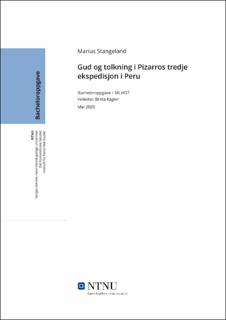| dc.contributor.advisor | Kägler, Britta | |
| dc.contributor.author | Stangeland, Marius | |
| dc.date.accessioned | 2021-09-13T16:01:33Z | |
| dc.date.available | 2021-09-13T16:01:33Z | |
| dc.date.issued | 2020 | |
| dc.identifier | no.ntnu:inspera:57494038:22880655 | |
| dc.identifier.uri | https://hdl.handle.net/11250/2775497 | |
| dc.description.abstract | Religion stod sentralt i legitimeringen av den spanske erobringen av Peru på 1500-tallet, blant annet som en del av misjonsvirksomhet. I denne prosessen ble det viktig å vise til at krigføringen mot de innfødte var bygd på et rettferdig grunnlag, og som en konsekvens ble et rettslig dokument, El Requerimiento, utarbeidet som grunnsteinen for den spanske religiøse legitimeringen av erobringene i Amerika. Fokuset her vil være på Pizarros tredje ekspedisjonen i Peru, spesielt på det avgjørende første møtet mellom conquistadorene og inkakeiseren Atahualpa i Cajamarca i 1532. Møtet endte med en massakre av inkadelegasjonen og kidnappingen av inkakeiseren; det var avgjørende for erobringen av Peru.
Oppgaven tar sikte på å undersøke den religiøse legitimeringen av dette møtet fra perspektivet til to førstegenerasjons krønikerforfattere, Jerez og Mena, og to andregenerasjons forfattere, Cieza de León og Betanzos. Ettersom dette var et møte mellom to svært ulike kulturer og språkbakgrunner, står tolkning og oversettelse sentralt i legitimeringen. Tre sentrale spørsmål vil forme utgangspunktet for analysen: Hvordan ble religion brukt til å legitimere den tidlige erobringen av Andesregionen, og hva var rollen til tolkning og oversettelse i dette? Hvem var tolkene og hva var deres posisjon i erobringen? Hvordan endret synet på erobringen av Inkariket og oversettelse fra første- til andregenerasjon krønikerforfattere?
I møtet i Cajamarca i 1532 ser man hvordan tolken får en sentral rolle i å oversette en kristen diskurs som er klart knyttet til El Requierimiento. I tillegg var oversettelsen av kristne symboler, som bibelen, en sentral del av hvordan møtet ble forstått av spanjolene, og hvordan man senere legitimerte handlingene. Oppgaven argumenter for at synet på tolkning og kulturforskjeller endrer seg mye fra første- til andregenerasjons forfattere, der den andre generasjonen i større grad problematiserte tolken og tolkningen. Videre kan man i analysen av møtet i 1532 se hvordan León og Betanzos er mer kritiske i sine framstillinger, mens førstegenerasjonen i større grad bruker tolken som et instrument for legitimeringen av møtet. Et sentralt argument i oppgaven er at man tydelig kan se at tolkning spilte en avgjørende rolle både som en del av legitimeringen av erobringen, men også som en måte å problematisere og kritisere den. | |
| dc.description.abstract | Religion was central to the legitimization of the Spanish conquest of Peru in the 16th century, which was particularly evident in the focus on missionary work; it was important to illustrate that the war against the natives was justifiable. Consequently, a judicial document, El Requrimiento, was written as part of the Spanish religious legitimization of the conquests in America. The focus in this thesis will be on Pizarro’s third expedition to Peru, particularly the first meeting between the conquistadors and the Inca emperor Atahualpa in Cajamarca in 1532. The meeting ended with the massacre of the Inca delegation and the kidnapping of Atahualpa that was decisive for the outcome of the expedition.
The thesis will examine the religious legitimization of this meeting from the perspective of two chroniclers of the first generation, Jerez and Mena, and two form the second generation, Cieza de León and Betanzos. The Spanish and the Incas represented two very different cultures and language backgrounds, which made translation vital to the legitimization of the encounter. Three questions are taken as the basis for the analysis: How was religion used to legitimize the early conquest of the Andes region, and what was the role of translation and interpretation in this? Who were the interpreters, and what was their position in the conquest? How did the view on the conquest of the Incas and translation change from the first generation chroniclers to the second generation?
In the meeting in Cajamarca I 1532, the interpreter played an important role in translating the Christian discourse of the conquistadors, which closely resembled the language of El Rquerimiento. Furthermore, the translation of Christian symbols, such as the Bible, was important to how the first meeting was understood by the conquistadors and the Spanish writers, as well as the legitimization of the meeting itself. By analyzing the differences between the first and second generation chronicles, the thesis argues that the second generation was more critical to the interpreter and his translations than the first one; Mena and Jerez used the interpreter more as an instrument to legitimize the encounter. Hence, interpretation was both central to legitimize the conquest, and to problematize and criticize it by pointing to the weaknesses of the translation. | |
| dc.language | | |
| dc.publisher | NTNU | |
| dc.title | Gud og tolkning i Pizarros tredje ekspedisjon i Peru | |
| dc.type | Bachelor thesis | |
